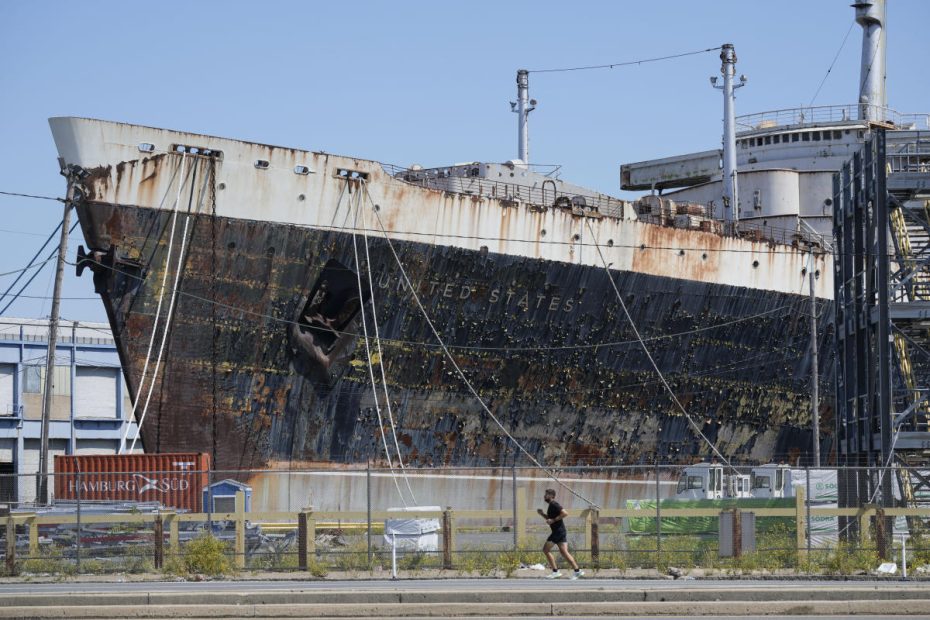PHILADELPHIA (AP) — The conservation group that oversees a legendary but aging ocean liner and its landlord have resolved a yearslong lease dispute that paves the way for a Florida county to turn the historic ship into the world's largest artificial reef.
A federal judge had ruled in June that the SS United States Conservancy had until September 12 to submit plans to move the ship, a 1,000-foot ocean liner that still holds the transatlantic speed record it set more than 70 years ago established. That deadline came and went, however, after the Conservancy filed a lawsuit accusing Penn Warehousing of sabotaging its efforts to sell the ship.
The Conservancy had reached a tentative agreement earlier this month with Okaloosa County on Florida's coastal Panhandle, a deal that was contingent on the lease dispute being resolved through court-ordered mediation. The deal that resolves that dispute was announced Friday.
Conservancy and county officials gathered Saturday at the Philadelphia pier where the ship is moored for a small transfer of ownership ceremony, although the deal with Okaloosa County still needs final approval from a federal judge, the Philadelphia reported Inquirer.
Okaloosa officials plan to scuttle the ship and create a barnacle-encrusted star in the county's constellation of more than 500 artificial reefs, making it a signature diving attraction that generates millions of dollars a year in local tourism spending for diving could generate. shops, charter fishing boats and hotels.
“We can tell you that you will not be lost, you will not be forgotten, you will no longer be neglected and abused,” Conservancy board member Thomas Watkins said in a farewell letter from the ship. “You will be rightly honored, cherished and loved in a new home and in a new dimension. You will no longer sail the seas, but you will be surrounded and caressed by them.”
Officials have said the deal to buy the ship could cost more than $10 million. The lengthy process of cleaning, transporting and sinking the ship is expected to take at least 1.5 years.
The lease dispute stemmed from a decision by Penn Warehousing in August 2021 to double the ship's daily dockage to $1,700, an increase that the conservancy declined to accept. The company had said through its lawyers that it wants to regain access to the berth so it can replace the ship with a commercial customer that will bring jobs and tax revenue to the city.
When the conservancy continued to pay the previous rate, set in 2011, Penn Warehousing terminated the lease in March 2022. After much legal wrangling, U.S. District Judge Anita B. Brody held a trial in January but also encouraged the two sides to settle to agree. take care of things instead of leaving it up to her.
She ultimately ruled that the conservancy's inability to pay the new rate did not constitute a breach of contract and did not entitle Penn Warehousing to damages. However, she found that under Pennsylvania contract law, the mooring agreement can be terminated at will with reasonable notice.
Christened in 1952, the SS United States was once considered a beacon of American engineering and also served as a military ship capable of transporting thousands of troops. On its maiden voyage in 1952, it shattered the transatlantic speed record in both directions when it reached an average speed of 36 knots, or just over 40 miles per hour, The Associated Press reported from aboard the ship.
During that voyage, the ship crossed the Atlantic Ocean in three days, 10 hours and 40 minutes, beating the time of the RMS Queen Mary by 10 hours. To this day, the SS United States holds the transatlantic speed record for an ocean liner.
The SS United States became a reserve ship in 1969 and later passed to several private owners who hoped to redevelop it. But ultimately they found their plans too expensive or poorly timed, leaving the ship stranded on the waterfront of South Philadelphia's Delaware River for years.

